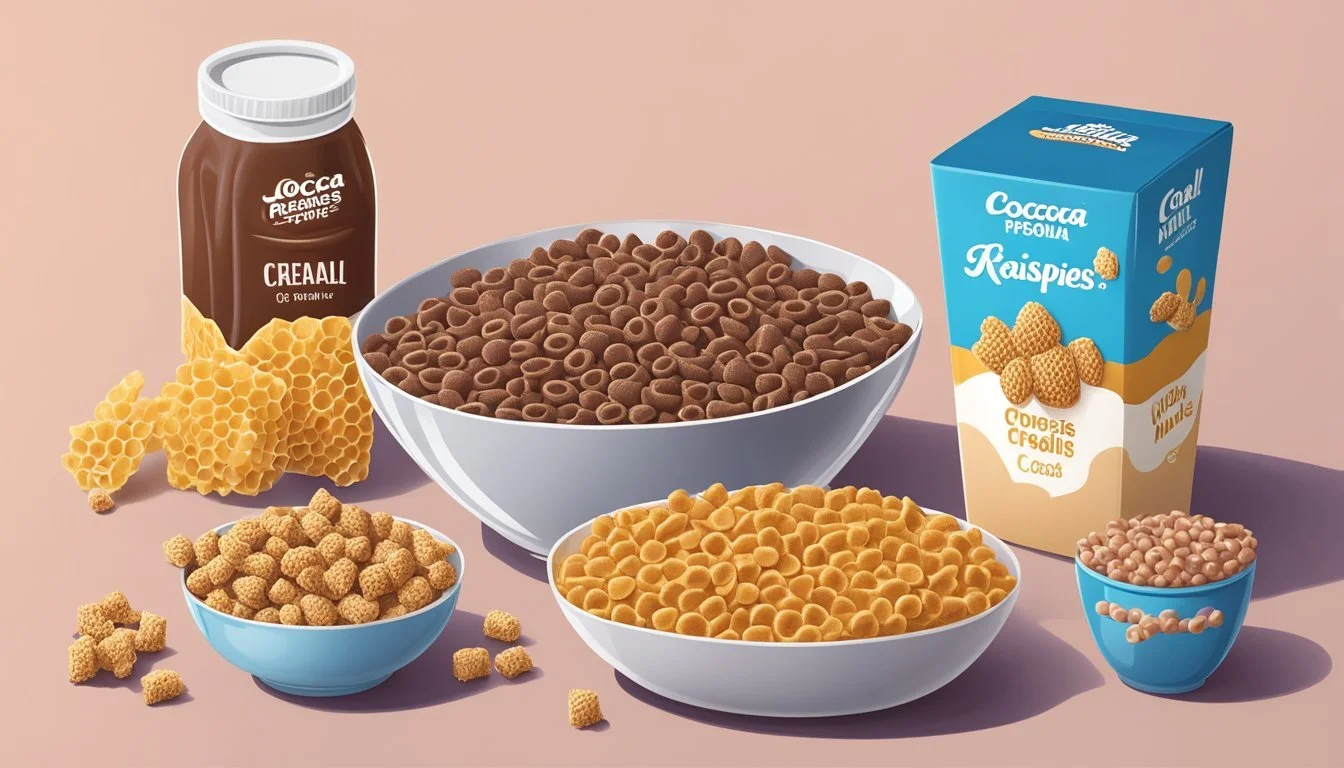Cocoa Krispies vs Honeycomb
A Nutritional Comparison and Taste Test
This Article is Part of Our Breakfast Cereal Guide with Details on Cocoa Krispies Nutrition and Honeycomb Nutrition
Cocoa Krispies and Honeycomb are two beloved cereals that have been staples in households for years, each offering unique tastes and nutritional profiles. Cocoa Krispies are notably higher in Iron, Vitamin E, Vitamin A, Vitamin C, Copper, Calcium, and Selenium, making them a nutrient-dense choice for those looking for a rich source of vitamins and minerals.
On the other hand, Honeycomb cereal shines in its Vitamin D and Fiber content, catering to different dietary needs. The crunch and mild sweetness of Honeycomb provide a distinct breakfast experience, particularly appealing to those who prefer a cereal with a firmer texture.
Comparing these cereals offers insight into their respective health benefits and considerations. While Cocoa Krispies contain less sodium, Honeycomb's higher fiber content can aid digestion. Both cereals have their own sets of advantages, making them suitable for different preferences and health goals.
Overview of Cocoa Krispies
Cocoa Krispies is a popular breakfast cereal produced by Kellogg's, known for its chocolate flavor and light, crispy texture. This section covers its history, nutritional profile, and taste experience.
Brand History and Kellogg's
Cocoa Krispies is a product of WK Kellogg Co, previously known as Kellogg's. First introduced in 1958, it is a cocoa-flavored version of the classic Rice Krispies cereal.
Different regions know Cocoa Krispies by various names such as Choco Krispis, Coco Pops, and Choco Pops. Available in boxed cereal and snack bar forms, they have become a staple for many breakfast tables. Kellogg's, founded in 1906, continues to innovate within its extensive cereal portfolio.
Nutritional Profile
Cocoa Krispies offers a balance of taste and nutrition. A typical serving provides essential vitamins and minerals, thanks to its fortified nature. Each serving includes a blend of vitamins like B6 and B12 as well as minerals like iron and calcium.
Despite its sweet taste, it contains a relatively moderate amount of sugar compared to other chocolate cereals. It's made from oven-toasted puffed rice and real chocolate, making it a more appealing option for a chocolate-flavored breakfast.
Taste and Texture Experience
Cocoa Krispies is renowned for its delightful chocolate flavor and light, crispy texture. The cereal is oven-toasted, which enhances its crispiness. When milk is added, it leaves behind a delicious chocolate milk, adding to its appeal.
The flavor is a balanced mix of chocolate and subtle sweetness, appealing to both children and adults. The light and airy texture makes it a satisfying breakfast choice, differentiating it from other, denser chocolate cereals.
Overview of Honeycomb
Honeycomb cereal has a unique place in the cereal market with its distinctive shape and flavor. It is sweet, crunchy, and contains various vitamins and minerals that contribute to a balanced diet. This overview will discuss the history of the brand, its nutritional profile, and the overall taste and texture experience.
Brand History
Honeycomb cereal has been a staple in American households since its introduction by Post Consumer Brands in 1965. Its hexagonal shape was designed to mimic real honeycombs, capturing the imagination of both children and adults. Post has maintained Honeycomb’s familiar look and flavor while occasionally introducing variations to keep the product fresh and engaging.
The cereal became popular for its creative marketing campaigns, which frequently featured the mascot "Honeycomb Kid" in the early years. Over time, the branding evolved to address changing consumer preferences, emphasizing its texture and fun eating experience. Despite changes in the market, Honeycomb has remained a beloved classic.
Nutritional Profile
Honeycomb cereal is known for its sweet flavor, primarily derived from sugar and corn syrup. Each serving provides approximately 110 calories, with a significant portion coming from carbohydrates. The cereal contains minimal fat, around 1 gram per serving.
Vitamins and minerals are also present, adding nutritional value. Honeycomb typically includes added vitamins like A, C, D, and multiple B vitamins, along with essential minerals such as iron and zinc. This nutrient fortification helps make it a more balanced breakfast option, though its high sugar content should be noted for those monitoring their intake.
Nutritional Highlights per Serving (1 cup):
Nutrient Amount Calories 110 Fat 1g Carbohydrates 24g Sugars 10g Proteins 2g Sodium 180mg Fiber 1g
Taste and Texture Experience
Honeycomb cereal is famed for its light, crispy texture and distinct honey-flavored sweetness. The airy composition allows it to remain crunchy in milk for a longer period, making it a satisfying choice for breakfast. Many fans appreciate the subtle balance between sweetness and crunchiness.
The large hexagonal shape also adds to the appeal, providing a unique tactile experience that many find enjoyable. As a result, Honeycomb is often consumed not just with milk, but also as a snack on its own. The cereal’s taste is designed to appeal to both children and adults, striking a balance that ensures its longevity in the market.
Comparative Analysis
Comparing Cocoa Krispies and Honeycomb reveals notable differences in flavor, nutritional value, ingredients, and market presence. These differences can help consumers make informed decisions based on taste preferences and dietary needs.
Flavor Profiles
Cocoa Krispies offer a rich chocolate flavor, appealing to those who enjoy sweet, chocolaty cereals. This flavor comes from real chocolate, making it a favorite among chocolate lovers.
Honeycomb, on the other hand, features a milder sweetness with a distinct honey taste. Its puffed cereal pieces provide a satisfying crunch, which contrasts with the lighter texture of Cocoa Krispies. Both cereals cater to different taste preferences, with Cocoa Krispies being more appealing to those with a sweet tooth looking for a chocolate fix, and Honeycomb suiting those who prefer a subtler sweetness.
Health and Nutrition
Cocoa Krispies are fortified with vitamins and minerals, making them a significant source of Iron, Vitamin E, Vitamin A, Vitamin C, Copper, Calcium, and Selenium. They contain less sodium and, despite their sweetness, are comparable in calories to other sugary cereals.
Honeycomb is rich in Vitamin D and fiber, which Cocoa Krispies lack. The fiber content in Honeycomb can aid in digestion and provide a sense of fullness. Comparing the sugar content, both cereals are relatively high, but Cocoa Krispies tend to have more due to the chocolate coating. While both have nutritional benefits, they serve different dietary needs.
Cereal Ingredients and Nutrient Content
Cocoa Krispies primarily consist of oven-toasted puffed rice with a chocolate coating. Key nutrients provided include:
Iron: 76% more daily value than Honeycomb.
Vitamin E, A, C: Significant presence.
Calcium and Selenium: Essential for bone and immune health.
Honeycomb cereal emphasizes its honey flavor and includes:
Vitamin D: Higher compared to Cocoa Krispies.
Fiber: Beneficial for digestive health.
Lower sodium content: Compared to standard sugary cereals.
Each cereal’s unique blend of ingredients caters to various nutritional priorities, from iron intake to calcium and vitamin D fortification.
Cultural and Market Presence
Cocoa Krispies, produced by Kellogg's, maintain a strong presence in grocery stores and retail giants like Target. Its chocolatey appeal has made it a staple in many households, often marketed towards children and chocolate enthusiasts.
Honeycomb, made by Post, also has a significant market presence, distinguished by its iconic hexagonal shapes and honey taste. The cereal is often promoted with a nostalgic appeal, aiming to attract both children and adults who grew up eating it.
Both cereals have established themselves in the market, yet their branding strategies and target audiences vary, reflecting their distinct tastes and nutritional compositions.
Consumer Preferences
Consumers often choose between Cocoa Krispies and Honeycomb based on various factors such as nutritional content, taste, and brand loyalty.
Market Trends and Popular Choices
Market trends indicate that both Cocoa Krispies and Honeycomb have a loyal following, but they appeal to different segments. Cocoa Krispies is favored by consumers looking for a chocolate-flavored cereal rich in vitamins and minerals. It's often chosen for its high iron content and lower sodium levels.
Conversely, Honeycomb attracts those who prefer a cereal with more fiber and Vitamin D. The unique honeycomb shape and sweeter taste make it popular among families with children. Both cereals maintain strong positions in the breakfast aisle, leveraging their distinct nutritional profiles and flavor offerings.
Consumer Reviews and Brand Loyalty
Consumer reviews reveal that taste and texture are significant factors in purchase decisions. Cocoa Krispies is praised for its chocolatey flavor and familiar snap-crackle-pop sound, evoking nostalgia among many consumers. Reviewers also appreciate its nutritional benefits, such as iron and vitamins.
Honeycomb, on the other hand, is often highlighted for its light, crispy texture and honeyed flavor. Consumers tend to remain loyal to their favorite cereals due to these distinctive characteristics. Brand loyalty is further cemented through effective marketing and nostalgic branding, which keeps both cereals a staple in many households.
Dietary Considerations
Cocoa Krispies and Honeycomb cereal each offer unique features that may appeal to different dietary needs and preferences. This section discusses calorie content, potential allergens, and their suitability for various diets.
Calorie Count and Serving Size
Cocoa Krispies:
A standard serving size of 1 cup (31g) of Cocoa Krispies contains approximately 120 calories. This makes it relatively calorie-friendly compared to other cereals. It also includes added vitamins and minerals, enhancing its nutritional profile.
Honeycomb Cereal:
A typical serving size of 1 cup (36g) of Honeycomb cereal is around 150 calories. Honeycomb provides a higher fiber content, with 3.2g of fiber per serving, which can be beneficial for digestive health.
Comparison:
Cocoa Krispies generally have fewer calories per serving than Honeycomb cereal. People focused on low-calorie diets might prefer Cocoa Krispies for a lighter option.
Allergen Information
Cocoa Krispies:
Cocoa Krispies are made using rice and often contain ingredients such as barley malt flavoring, making them potentially unsuitable for individuals with gluten intolerance. They also contain soy lecithin and may have traces of tree nuts and milk, which are common allergens.
Honeycomb Cereal:
Honeycomb cereal primarily consists of corn and oat flours. It is notable for being gluten-free, which can be a critical factor for those with celiac disease or gluten sensitivity. However, like Cocoa Krispies, it may still contain allergens like soy and milk.
Comparison:
Honeycomb may be a safer choice for those needing a gluten-free option. Consumers allergic to soy or milk should check the packaging carefully for both cereals.
Suitability for Different Diets
Low Fat & Low Carbs Diets:
Neither Cocoa Krispies nor Honeycomb is particularly low in carbohydrates. Cocoa Krispies have about 28g of carbs per serving, while Honeycomb has slightly more at 30g. Both cereals are low in fats, making them suitable for low-fat diets.
Low Calories & Low Glycemic Index Diets:
Cocoa Krispies' lower calorie count can be beneficial for low-calorie diets. Both cereals might not be ideal for low glycemic index diets due to their sugar content, which could cause spikes in blood sugar levels.
Gluten-Free Diets:
Honeycomb cereal is a clear winner here, being explicitly gluten-free. Cocoa Krispies, on the other hand, might not be suitable due to the presence of barley malt.
Each cereal has its strengths and can cater to different dietary needs, making them versatile options for various consumers.
Environmental and Economic Factors
Cocoa Krispies and Honeycomb differ in their production and sustainability practices as well as their cost implications. It's crucial to understand how these factors impact both the consumer and the environment.
Production and Sustainability
Cocoa Krispies primarily use cocoa, a commodity heavily associated with significant environmental and social issues. Cocoa farming can lead to deforestation and loss of biodiversity. Issues like child labor and farmer poverty are also prevalent. Sustainable cocoa farming practices aim to address these problems through certifications and better farming techniques.
On the other hand, Honeycomb cereal production relies primarily on corn and sugar. Corn farming is less labor-intensive and doesn’t carry the same social concerns as cocoa farming. However, it can still have environmental impacts such as water usage and pesticide application. Corn farms are often large-scale operations, which can lead to monoculture practices and soil depletion.
Cost Comparison
When it comes to price, Cocoa Krispies are generally more expensive than Honeycomb cereal. This is due to the higher cost of cocoa as a raw material and the complexities involved in ensuring sustainable farming practices. The price at a grocery store may vary depending on the brand and specific product.
Honeycomb cereal, relying on more readily available ingredients like corn, usually has a lower production cost. Consumers might find Honeycomb cereal to be a more affordable option. Additionally, the price of these cereals can be influenced by factors such as brand promotions and bulk buying options at stores like Target.
The cost difference reflects the varying inputs and processes involved in bringing these cereals to the shelf, impacting both the producer and consumer choices.
Closing Thoughts
Cocoa Krispies and Honeycomb both offer distinct choices for breakfast cereal lovers.
Cocoa Krispies stand out for their rich chocolate flavor and crispy texture. They are higher in iron, Vitamin E, Vitamin A RAE, Vitamin C, Copper, and Selenium. This makes them a nutrient-packed option.
Honeycomb provides a different nutritional profile. It is richer in Vitamin D and fiber, which can be beneficial for digestive health. The larger, airy texture of Honeycomb can be appealing to those who prefer a lighter crunch.
When choosing a healthy breakfast, consider your nutritional needs. If more iron and vitamins are important, Cocoa Krispies could be the better choice. If fiber and Vitamin D are priorities, Honeycomb may suit you better.
Consumer advice: It's essential to read ingredient labels and nutritional facts. Different cereals can serve different dietary needs. Both cereals can be enjoyed as part of a balanced diet, but moderation is key due to their sugar content.
Here's a quick comparison:
Nutrient Cocoa Krispies Honeycomb Iron Higher Lower Vitamin D Lower Higher Fiber Lower Higher Sodium Lower Higher
In the end, both cereals have their unique features that can cater to varying preferences and dietary requirements.









